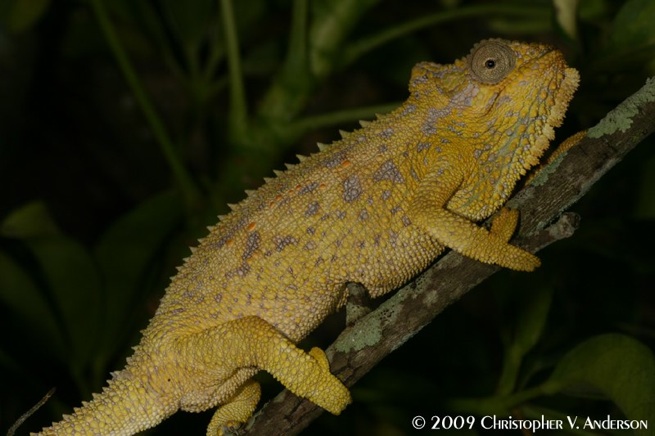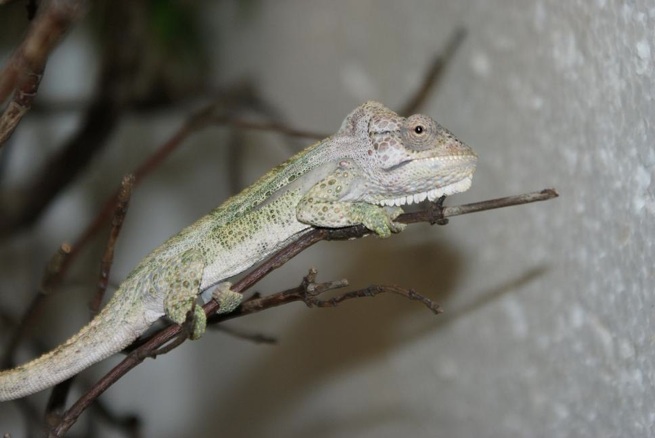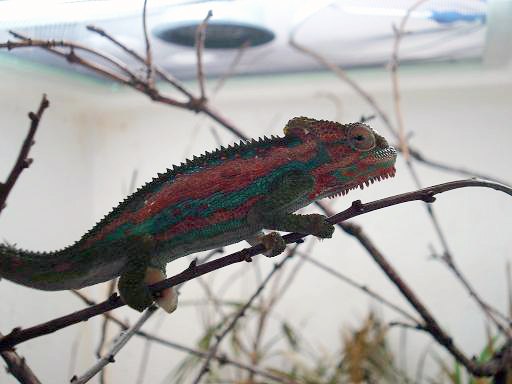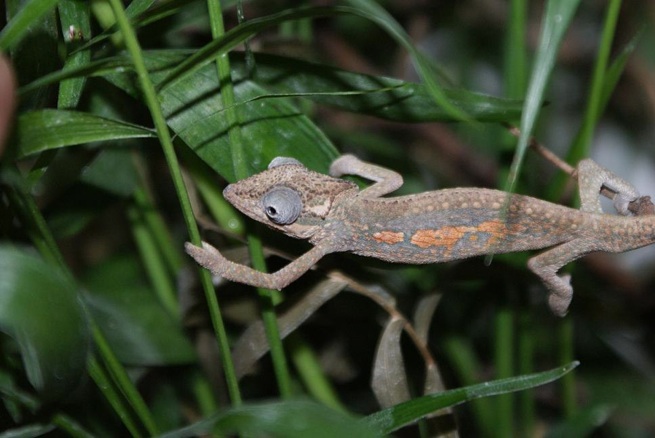



Keeping Bradypodion
By Steven Deckers & Christopher V. Anderson
Citation:
Deckers, S. & C.V. Anderson, (2010). Keeping Bradypodion. Chameleons! Online E-Zine, July 2010. (http://www.chameleonnews.com/10JulDeckersAnderson.html)
Introduction
The South African Dwarf Chameleons of the genus Bradypodion are a beautiful group of 17 currently recognized small to moderate sized, ovoviviparous species from Southern Africa. A few of these species are kept in limited numbers in Europe and a couple in extremely limited numbers in the US. Here, we provide brief descriptions of four of those species, which the authors have experience with and general notes on our experiences keeping the various members of this genus in captivity, in the hopes that these populations continue to flourish.

Female Bradypodion transvaalense. Photo by Christopher Anderson.
Brief Species Descriptions
Bradypodion damaranum (Boulenger 1887)
Knysna Dwarf Chameleon
Within the genus, Bradypodion damaranum is one of the larger species, reaching a maximum length to over 18 cm (7”). The snout-vent length is on average between 60 and 70 mm (2.25-2.75”) with the tail of both males and females being longer than the snout-vent length. The head has a well-developed casque which points backward. The ridges on the head are prominent and consist of large round scales. The gular crest consists of a series of laterally flattened dermal lobes. These lobes are wider than long and overlap, and are covered with smaller scales. The body scalation consists mainly of granular scales. Further, there are typically two rows of enlarged tubercle scales on the flanks. Behind the front legs there is a patch of skin lacking scalation will find a soft piece of skin that seems to be no scales. The dorsal crest is composed of conical scales continuing almost to the end of the tail.

Adult male Bradypodion damaraum. Photo by Steven Deckers.
Bradypodion damaranum is one of the most colorful chameleon species. The background color of males is usually green or greenish-blue while in females and young animals usually brown or yellowish-brown. The bare piece of skin behind the front legs is usually yellow or orange-like color. The scales on the main ridges are usually intensely colored from yellow to dark blue or black. Behind the head of males usually exhibits a color gradient with different coloration from the background color. This gradient is typically blue, purple, red, yellow or black. This gradient can change in size up to 2/3rd of body length. The females also have this pattern with them but this is usually less brightly colored.

Adult male Bradypodion damaranum. Photo by Steven Deckers.
This species has litters between 2 and 20 neonates. Gestation lasts approximately three to six months depending on the season. Gestation is significantly shorter in summer than in winter.

Adult female Bradypodion damaranum. Photo by Steven Deckers.
The name of the “damaranum” suggests that they occur in Damaraland. Interestingly, this is not where the species is found but rather the researcher was mistaken in the location of Knysna (where the first of this chameleon species is found).
This species is currently kept and bred in reasonable numbers in Europe but neither author are aware of them being kept in the US at the time of writing.
Bradypodion pumilum (Gmelin, 1789)
Cape Dwarf Chameleon
Bradypodion pumilum is a larger Bradypodion species reaching up to 19cm (7.5”) in total length. This species exhibits multiple ecotypes with considerable variation in their morphology and coloration, however only the typical form will be discussed here. The head has a reasonably well-developed casque which points backward. The ridges on the head are prominent and consist of large round scales. The gular crest consists of a series of laterally flattened dermal lobes. These lobes are longer than wide, and are covered with smaller scales. The body scalation consists mainly of granular scales with enlarged tubercle scales scattered around the flanks and limbs. Further, there are typically one to two rows of enlarged tubercle scales on the flanks. The dorsal crest is composed of conical scales continuing a considerable distance down the tail. The body is typically overall green in coloration but can be quite variable. Colors exhibited include blue, yellow, orange, purple, pink, brown and black.

Adult male Bradypodion pumulim of the “typical form.” Photo by Steven Deckers.

Adult female Bradypodion pumilum of the “typical form.” Photo by Steven Deckers.
This species is known to give birth 2-21 neonates after a gestation of approximately four months. These clutches are typically born in the summer months, although 3 clutches can be born per year. This species is kept in extremely limited numbers in Europe and neither author are aware of this species being kept in the US at the time of writing.

Neonate Bradypodion pumilum. Photo by Steven Deckers.
Bradypodion setaroi Raw, 1976
Setaro’s Dwarf Chameleon
Bradypodion setaroi is a smaller species reaching up to 12cm (4.75”) in total length. The tail length is approximately equal to that of the snout-vent length. The head is rather elongate in shape with a slightly elevated casque that points backward. The gular crest is comprised of triangular shaped, dermal flaps that are covered in small scales. The gular pouch has a series of throat grooves. The dorsal crest has widely spaced, large conical scales extending approximately half way down the back. This species is typically a grey to brown in color with an orange stripe down the side of the body. The body and tail often exhibit a mottled green patterning with bluish grey color in the gular region.

Adult male Bradypodion setaroi. Photo by Steven Deckers.
This species gives girth to 2 to 10 neonates after a gestation of approximately three to six months, depending on the season. This species is kept in limited numbers in Europe but neither author are aware of this species being kept in the US at the time of writing.
Bradypodion thamnobates Raw, 1976
Natal Midlands Dwarf Chameleon
Bradypodion thamnobates reaches up to 17cm (6.5”) in total length with the tail being equal to longer than the snout-vent length. The casque is well-defined and rounded at the back. The gular crest is formed by large, overlapping dermal lobes covered in small scales and numerous throat grooves in the gular pouch. The dorsal crest is formed by large conical scales extending onto the tail. These often alternate in size. The limbs and tail exhibit numerous enlarged tubercles with a couple present on the flanks.

Male Nothingham Road Bradypodion thamnobates. Photo by Steven Deckers.

Female Nothingham Road Bradypodion thamnobates. Photo by Steven Deckers.
Two forms are currently kept in captivity: the Nothingham Road and Mooi River, locales. The Nothingham Road morph is the typical morph. The Mooi River morph seems to resemble the ‘emerald dwarf chameleon’ as described in “Chameleons of Southern Africa” by K. Tolley & M. Burger. The Nothingham Road has a basic brown/gray coloration where the males my have a redish or yellowish coloration on the flanks. The Mooi River has a more green basic coloration where the males get yellowish and blue colorations. The gular area from the Nothingham is white in males and females where adult Mooi Rivers are yellow.

Male Mooi River Bradypodion thamnobates. Photo by Steven Deckers.

Female Mooi River Bradypodion thamnobates. Photo by Steven Deckers.
Of the Bradypodion currently kept in captivity, the Nothinghand Road locale of Bd. thamnobates appears to be the easiest to keep and breed.
This species gives birth to 2-26 neonates. Their gestation ranges from 3-9 months, depending on the season. The Nothingham Road locale is currently kept and bred in reasonable numbers in Europe and in very limited numbers in the US. The Mooi River locale is much less common in Europe and neither author are aware of this species being kept in the US at the time of writing.

Juvenile male Mooi River Bradypodion thamnobates. Photo by Steven Deckers.

Juvenile female Nothingham Road Bradypodion thamnobates. Photo by Christopher Anderson.
Bradypodion transvaalense (FitzSimons, 1930)
Wolkberg Dwarf Chameleon
Some research has indicated that this species may comprise as many as 9 distinct species. Bradypodion transvaalense reaches approximately 15cm (6”) in total length with the tail being equal or longer in length to the snout-vent length. The casque is enlarged and pointed upward. The gular pouch has shallow throat grooves and the gular crest is formed by laterally compressed, often overlapping, dermal lobes covered in small scales. The dorsal crest is formed by large, widely spaced conical scales extending onto the tail. Enlarged tubercle scales, often forming one or two rows, are scattered on the flanks.

Adult female Bradypodion transvaalense. Photo by Christopher Anderson.
Colorations and patterns are highly variable depending on the population. Typically this species is alive to green in coloration. Other individuals are more brown to orange. The gular pouch is light in color with males exhibiting an orange or white band on the flanks during display that is often outlined by black or green. Some individuals exhibit a pale blue color.

Adult male Bradypodion transvaalense in display. Photo by Christopher Anderson.
This species gives birth to clutches of 7-19 neonates in the late winter or early spring. They are currently kept and bred in very limited numbers in the US and Europe.

Newborn Bradypodion transvaalense. Photo by Christopher Anderson.
General Notes on captive Husbandry and Propagation
As with other chameleon species, members of the genus Bradypodion require good ventilation to thrive. That said, while screen enclosures are utilized during the periods the authors house their Bradypodion ourdoors, both authors utilize glass terrariums when housing their Bradypodion indoors. Glass terrariums are different from aquariums, in that they are specially designed with mesh ventilation on the top and bottom-front of the enclosure creating a high level of airflow (more information on these enclosures can be found in the Glass Terrariums article of this issue). These terrariums vary in size depending on the species and age, including 30 x 30 x 45cm (12” x 12” x 18”), 25 x 60 x 60cm (10” x 24” x 24”), 36 x 60 x 60cm (14” x 24” x 24”), 40 x 40 x 60cm (16” x 16” x 24”), 45 x 45 x 60cm (18” x 18” x 24”) and 50 x 60 x 60cm (20” x 24” x 24”). Deckers adheres white Styrofoam to three sides of the enclosure to promote light reflectance into the enclosure, while Anderson utilizes a decoratively molded Styrofoam back and light diffuser panels from overhead fluorescent light fixtures as visual barriers on the two sides that allow light transmission. These terrariums are fully planted with drainage layers, organic soil and various types of plants including Ficus, Schefflera, Epipremnum aureum (pothos), grasses, Chamaedorea palms, Thunbergia alata, an asparagus species or bamboo species. The setups are completed with branches and twigs of various sizes.

Male Bradypodion damaranum on white Styrofoam siding of one of Decker’s terrariums. Photo by Steven Deckers.
All lighting is placed on the top of each terrarium. Deckers utilizes 10-20W Halogen lamps for heat and Truelight lamps for ambient and UV lighting. Truelights are known for giving almost natural lighting and some UV. This UV is only in limited quantities but Deckers has not observed any negative effects and has seen the coloration of his chameleons change for the better since using them. Deckers does supply supplemental calcium and vitamin D in the drinking water, however, to make sure they get sufficient calcium absorption. Anderson, on the other hand, utilizes a normal low wattage incandescent bulb for heat, a 6500K compact fluorescent bulb for the plants and ambient light, and Reptiglo 5.0 compact fluorescent bulb for UVB. Due to the quick decrease in the radiance levels of the UV from these bulbs, in addition to their high UV radiance levels close to the bulb itself, Anderson carefully utilizes a UV meter on each enclosure to ensure proper placement.

Female Bradypodion transvaalense. Photo by Christopher Anderson.
This species seems to benefit from seasonal variation in temperatures. In the winter, the authors try to maintain average daytime temperatures between 20-22 degrees Celsius (68-72 degrees Fahrenheit) with night temperature drops to 8-14 degrees Celsius (46-57 degrees Fahrenheit). During the summer, average daytime temperatures range from 20-28 degrees Celsius (68-83 degrees Fahrenheit) with night temperatures dropping to 13-18 degrees Celsius (55-65 degrees Fahrenheit). During certain weeks of the year, these night temperatures may not be dropped below 20 degrees Celsius (68 degrees Fahrenheit), however a cooling system such as an air conditioner helps to ensure these temperature drops at night when kept indoors, as well as prevent daytime temperatures from raising too high. Both authors try to avoid temperatures above 28 degrees Celsius (83 degrees Fahrenheit), although in the wild some of these species are exposed to temperatures as high as 35-40 degrees Celsius (95-104 degrees Fahrenheit) for certain periods. The difference is in the wild, these animals are able to take advantage of microclimates and other thermoregulatory behaviors that are difficult to replicate in captivity. Additionally, the moisture and humidity levels during these periods are quite different then what is typically seen in Europe and the US. Additionally, it should be noted that lower winter temperatures occur where many of these species occur than these animals are subjected to in captivity, including some ranging below freezing.
Watering should be provided daily. The authors mist their Bradypodion once to twice a day, first thing in the morning and sometimes later on in the day. When kept in glass terrariums, each misting session does not need to be as intensive as it would be when kept in screen enclosures. These enclosures hold humidity better and as a result, animals maintain their hydration longer in these enclosures, but too much misting can result in respiratory or skin infections.

Juvenile male Nothingham Road Bradypodion thamnobates. Photo by Christopher Anderson.
Deckers feeds his Bradypodion primarily fruitflies, which they seem to love. Further he feeds crickets, grasshoppers, other flies, roaches and waxworm moths). Anderson feeds primarily houseflies and crickets with silkworms as a treat and fruitflies for neonates. Bradypodion damaranum seem to really prefer flies and tend to only eat a few crickets, which species such as Bd. thamnobates seem to love crickets and eat other feeders readily. All feeders, including fruitflies and houseflies, should be carefully gut loaded so that they are as nutritious as possible. Both authors feed their adults 2-3 times per week with neonates being fed daily.

Neonate Bradypodion transvaalense feeding on fruitflies. Photo by Christopher Anderson.
Deckers notes that in The Netherlands, he keeps a portion of his chameleons outdoors from May to September/October. He only keeps a portion of his group outside for two reasons. First, there is always a risk of theft when keeping animals outside. More importantly, however, about 7 years ago, he experienced a loss of a very large breeding group of montane species when he moved his animals back inside from being outside. He’s never been sure about the cause but he believes that it had to do with differences caused by the temperatures of the air inside and outside. Indoors, he has been able to create the same temperature conditions as outside better in recently years and has been starting to put more of his animals outside each year. He still, however, never puts his complete group of any given species outside.
When trying to breed Bradypodion, Deckers recommends trying to have an extra male of each species as introduction of a second male and the subsequent male-male competition often stimulates the male to breed when he sees a female again. Additionally, once you begin breeding attempts, try to keep the pair together as they are likely to mate over a period of days and often are shy and will only do so when you are not looking. On the other hand, you should be careful to keep an eye on the pair to make sure the male does not become too pushy and continually chase the female, in which case, the pair should be separated. This seems particularly common with Bd. damaranum.

A pair of Mooi River Bradypodion thamnobates. Photo by Steven Deckers.
Pair of Bradypodion setaroi breeding. Photo by Steven Deckers.
After mating, gestation ranges from 3-8 months, depending on the species and season, at which point 2-26 small neonates are born. Both authors have kept them in the same type of glass terrarium as the adults, only in the smaller sizes—30 x 30 x 45cm (12” x 12” x 18”), 25 x 40 x 60cm (10” x 16” x 24”), 40 x 40 x 60cm (16” x 16” x 24”). During the first three months, the authors keep their neonates in small groups of 10 or fewer. Their primary food at this age is fruitflies, which are offered daily. At around 3 months of age, most species can start to be sexed, although Bd. damaranum is still difficult to sex at this age.

Neonate Bradypodion pumilum. Photo by Steven Deckers.
Care should be made to observe these animals regularly for health concerns. Certain species, particularly Bd. pumilum and Bd. transvaalense, appear prone to mouth and eye issues, often forming abscesses on the head. These infections seem to be treatable with prescription antibiotics from your vet but should be administered immediately upon the issue appearing.

Abscess and eye infection in Bradypodion transvaalense. Photo by Christopher Anderson.
Conclusion
The members of the genus Bradypodion offer a challenging group of species to keep and breed in captivity but to those keepers dedicated and willing to provide for their specialized care, they are quite rewarding. Efforts should be made to ensure this species is put into breeding situations, whenever possible, to maintain the current populations as legal sources of new blood are limited by South Africa’s strong regulations protecting them from export. Overall, these animals are incredible beautiful and fascinating animals that the authors feel privileged to be able to work with.
References
Branch, W.R. (1998). Field Guide to Snakes and Other Reptiles of Southern Africa. 3rd Edition. Struik Publishers, Cape Town, South Africa.
Necas, P. (2004). Chameleons: Nature’s Hidden Jewels. 2nd Edition. Chimaira Buchhandelsgesellschaft, Germany.
Tolley, K.A. & M. Burger (2007). Chameleons of Southern Africa. Struik Publishers, Cape Town, South Africa.

Steven Deckers

Steven Deckers is a chameleon keeper from The Netherlands. He has been keeping chameleons since the late 1990s. He has kept about 30 species over the years, having bred approximately 20 of them. In particular he likes the South African chameleon species. In addition to chameleons, Steven also keeps South African Cordylus species.

Christopher V. Anderson

Chris Anderson started keeping chameleons in 1997 and since then has worked with over 50 different species. Having spent time in the jungles of South East Asia, among other areas, aiding in research for publication, he has traveled to over 35 countries, including chameleon habitat in 6. Included in these, he has traveled throughout Madagascar in search of, and conducting personal research on the chameleons of the region. Having received his B.S. in Animal Science from Cornell University, Chris is currently a Ph.D. Candidate at the University of South Florida’s Department of Integrative Biology studying the effects of temperature on ballistic tongue projection and tongue retraction in chameleons for his dissertation. Some of his research has been published in top scientific journals and featured in popular press and news outlets all over the world. Currently, Chris is the Editor and Webmaster of the Chameleons! Online E-Zine. Chris’ personal website can be found at www.chamaeleonidae.com and he can be emailed at Chris.Anderson@chameleonnews.com or cvanders@mail.usf.edu.









Join Our Facebook Page for Updates on New Issues:
© 2002-2014 Chameleonnews.com All rights reserved.
Reproduction in whole or part expressly forbidden without permission from the publisher. For permission, please contact the editor at editor@chameleonnews.com
